| |
 |
 |
 |
| Comment on this report, or find other reports. |
 |
| Our Mystery Worshippers are volunteers who warm church pews for us around the world. If you'd like to become a Mystery Worshipper, start here. |
 |
| Find out how to reproduce this report in your church magazine or website. |
|
|
| 3038: Old St Joseph's, Philadelphia, Pennsylvania, USA |
 |
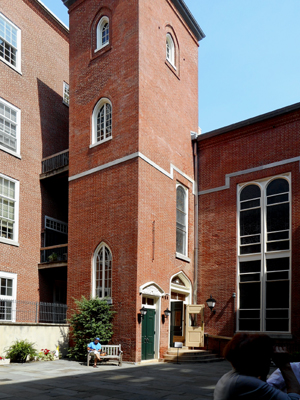 |
 |
Mystery Worshipper: Paterfamilias.
The church: Old St Joseph's National Shrine, Philadelphia, Pennsylvania, USA.
Denomination: Roman Catholic, Archdiocese of Philadelphia. It is administered by priests of the Society of Jesus, more commonly known as the Jesuits.
The building: Built in 1839, it is the third to occupy the site, the first being a home chapel in the pastor's residence. Almost impossible to see from the street, it has been described as being "as carefully hidden away as a martyr’s tomb in the catacombs." Legend has it that Benjamin Franklin advised the pastor to keep the building concealed, as toleration for a "Popish priest in a Romish chapel" might run thin despite Pennsylvania's reputation as a bastion of religious freedom. (Franklin’s advice was prescient: the parish endured anti-Catholic rioting in 1844.) One enters an unassuming courtyard from a side alley via a narrow arch with iron gates. The current building was extensively renovated in 1886, with further renovations in 1904. The interior has an unusual horseshoe balcony, impressive stained glass windows, and two prominent paintings: one dating from 1840 and located behind the altar; it is by a parishioner, Sylvano Martinez, and depicts the Crucifixion. The other, on the ceiling, is by the Italian-American artist Filippo Costaggini, who decorated numerous churches and was responsible for eight of the friezes in the rotunda of the US Capitol in Washington. It is entitled Apotheosis of St Joseph. The Stations of the Cross are bas-relief in painted wood, with an unusual strip at the top (the same for each station), showing naked cherubs celebrating (I will assume) the redemptive act of Our Lord.
The church: The Jesuits’ presence in Pennsylvania dates from 1729, when Father Joseph Greaton arrived in Philadelphia, attracted to a community where the Quaker William Penn’s Charter of Privileges (1701) guaranteed religious freedom to any who “worshiped one God.” Even so, a celebration of the Catholic mass violated English law, and the Provincial Council was urged to forbid these services. The Council concluded that the Charter of Privileges took precedence. From 1733 until the Declaration of Independence, Old St Joseph’s was the only church anywhere in the English speaking world in which mass could legally be celebrated.
Old St Joseph’s has had a significant impact on Philadelphia throughout its history. Its second pastor, Father Robert Harding, worked with the Quaker Anthony Benezet in ministering to Acadian refugees who were exiled by the British from Nova Scotia – a story memorialized by Henry Wadsworth Longfellow in his great epic poem Evangeline. Harding was also a subscriber to the building of America’s first hospital, Pennsylvania Hospital. Old St Joseph’s warmly welcomed Irish and Italian refugees in the 19th century. African-Americans attended Old St Joseph’s from its earliest days, and some of these families are known to have rented gallery pews. Eight parishes trace their roots to Old St Joseph’s, as do St Joseph University and St Joseph Preparatory School.
The early years of the 20th century were difficult for the parish, but with the establishment of the Independence National Historical Park in 1950 and an increased emphasis by the city of Philadelphia on urban renewal at about the same time, Old St Joseph’s again became a thriving and diverse parish. Today there are active ministries for young adults (including a softball team, the Sluggin’ Joes), and (among their many social justice ministries) a Faith, Food and Friends program, which works with men struggling with addiction, homelessness or poverty. The week we were in Philadelphia, parishioners were invited to an interfaith program to celebrate Ramadan and share “the joy of breaking fast” with members of the Muslim community. In 1976 the parish was one of the founding members of Old Philadelphia Congregations, a consortium of churches and synagogues that owe their storied histories to William Penn’s Charter of Privileges. There are four weekend masses, daily masses at noon, and confessions heard each weekday morning before the noon mass. The music program is reputed to be of high quality.
The neighborhood: Old St Joseph's is in Philadelphia's historic district known as Society Hill, within easy walking distance of Independence Hall and the Liberty Bell. The name "Society Hill" has nothing to do with high society, but rather is derived from the Free Society of Traders, whose offices were located there. It is a charming neighborhood of cobblestone streets and Georgian and Federal row houses, and boasts the largest concentration of original 18th and early 19th century residential architecture of any place in the United States. The church is on Willings Alley, named after one of the wealthiest men in colonial America. The cheapest Willings Alley residence today sells from upwards of $500,000.
The cast: The service leaflet gave no names, but from the parish website I noted that the Revd Philip Florio, SJ, pastor, was celebrant and homilist.
The date & time: Thirteenth Sunday in Ordinary Time, June 26, 2016, 11.30am.
Comment:
We have received a comment on this report.
What was the name of the service?
Mass.
How full was the building?
I would guess that downstairs seating could hold about 275. It was about two-thirds full. I am told the balcony can accommodate an additional 100.
Did anyone welcome you personally?
No, but we arrived early, as we had been warned that the church was not easy to find. Those entering later were greeted by a group of ushers. At the beginning of mass all visitors were asked to stand, and the congregation applauded.
Was your pew comfortable?
Quite.
How would you describe the pre-service
atmosphere?
Quiet and reverent, with just a bit of rehearsal by cantor and organist from the balcony.
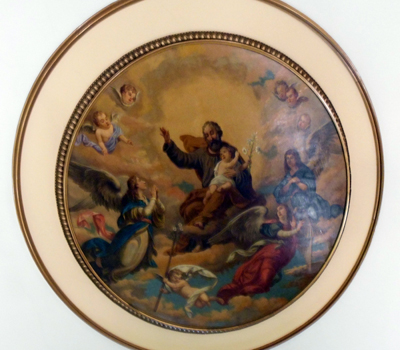
What were the exact opening words of the
service?
"Good morning, and welcome to Old St Joseph's, the Jesuit parish in Philadelphia," by the lector. He proceeded to tell us where to find music for the service and how we would receive communion.
What books did the congregation use during the
service?
Ritual Song, a 1996 publication of GIA Publications of Chicago. These were available in the rear of the church.
What musical instruments were played?
Organ, installed in 2012. As a testament to how far matters have progressed since the days of the "Popish priest in a Romish chapel," the instrument, opus 407 of the venerable EM Skinner Organ Company, was donated by the Episcopal Bishop of Pennsylvania.
It came from a now-closed Episcopal church in a Philadelphia suburb. The pipes occupy the original case by the 19th century organ builder Henry Corrie, which is the only surviving Corrie installation known to exist.
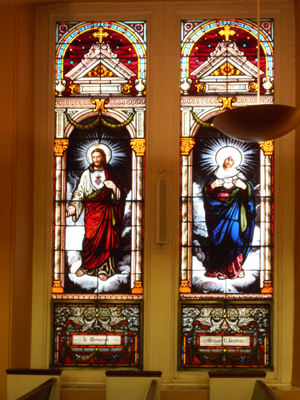
Did anything distract you?
I kept thinking about the cavorting cherubs above the Stations of the Cross.
Was the worship stiff-upper-lip, happy clappy, or
what?
Very formal. Incense was used in all of the usual places, and bells were rung at the consecration. Music was very traditional, including the Agnus Dei chanted in Latin. Communion was received in both kinds.
Exactly how long was the sermon?
14 minutes.
On a scale of 1-10, how good was the preacher?
8 – The pastor spoke from the front of the nave, without notes. He's an accomplished public speaker, although I thought the sports analogy with which he opened his sermon was forced.
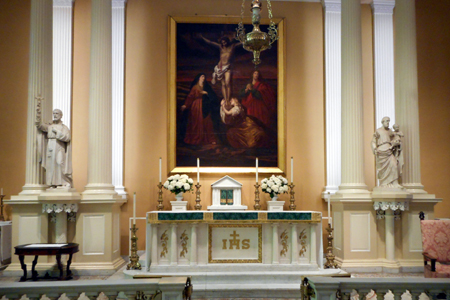
In a nutshell, what was the sermon
about?
He began by talking about his experiences with informal sports growing up in South Philly, and how, though he was good at running, he lacked coordination, and thus was almost always chosen last for a team. This he compared to the gospel for the day (Luke 9:51-62 – Jesus makes it clear what it means to follow him). God chooses those who will be on his team; God says, "Follow me." He noted that there is a battle between good and evil, as he knows well from the confessions he hears. He concluded by reading a passage from St Ignatius Loyola's Spiritual Exercises, and asked us to close our eyes as he read.
Which part of the service was like being in
heaven?
The liturgy was carefully celebrated, and the music very professionally done. I regret that, as it was summer, I did not have the chance to hear their schola cantorum. The cantor was the most unobtrusive Catholic cantor I have experienced; he went simply about his tasks without the mega-cantor gestures and endless proclamations of page numbers that many cantors bring to this role. However ...
And which part was like being in... er... the other place?
... this same cantor was occasionally below pitch; this may have been due to the distance between cantor and the organ in the rear gallery.
What happened when you hung around after the service looking lost?
The woman seated in front of us greeted us warmly and said that she hoped we would be able to worship with them again. We then entered a line to leave by the only exit, where Father Florio was waiting to greet us.
How would you describe the after-service
coffee?
Pretzels, popcorn and cookies, with a variety of juices in plastic cups. However, not many of the congregation chose to go to the coffee hour.
How would you feel about making this church your regular (where 10 = ecstatic, 0 = terminal)?
9 – Materfamilias and I would want to hear the schola before making a decision, but there seems to be a strong commitment to social justice, and a diverse congregation.
Did the service make you feel glad to be a
Christian?
Yes.
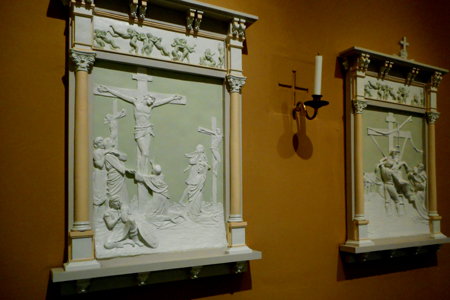
What one thing will you remember about all this in seven days' time?
The Stations of the Cross.
|
|
|
 |
 |
 |
| We rely on voluntary donations to stay online. If you're a regular visitor to Ship of Fools, please consider supporting us. |
 |
 |
 |
| The Mystery Pilgrim |
 |
| One of our most seasoned reporters makes the Camino pilgrimage to Santiago de Compostela in Spain. Read here. |
 |
 |
 |
| London churches |
 |
| Read reports from 70 London churches, visited by a small army of Mystery Worshippers on one single Sunday. Read here. |
| |
|
|
|
|


